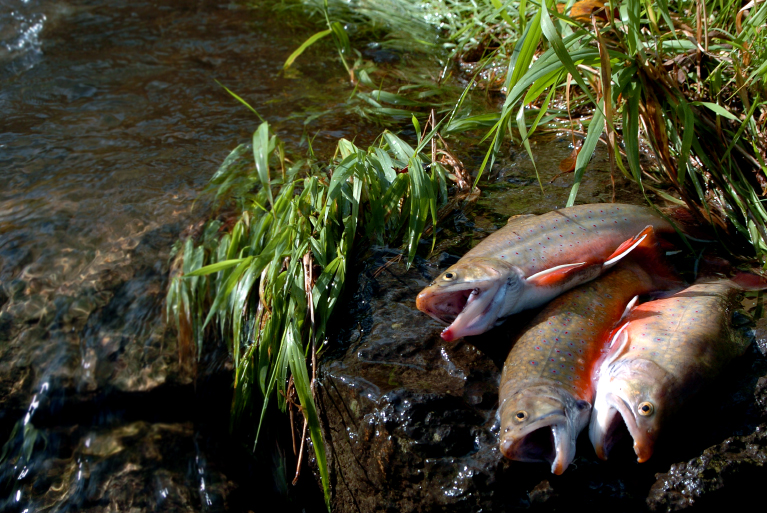The Haudenosaunee developed a cooperative culture, with each member of a village or clan responsible for helping others in the group. Women tended the crops together; men organized hunting and fishing parties together, capturing enough to provide food, clothing and tools for the entire village. Boys were allowed to join hunting parties when they had killed a deer by themselves.
In 1653, Dutch visitor Adriean Cornelissen van der Donck described how the Haudenosaunee hunted:
“They have a passion for hunting and fishing, and observe set times of the year for it. Spring and part of summer are given over to fishing, but when the game begins to increase in the woods and the early hunting season approaches, many young men quit fishing. The elderly go on longer, until winter and the main hunting season, but do in the meantime take part to the extent of setting snares.
“Youths and fit men often go out hunting bears, wolves, fishers, otters, and beavers. Deer are hunted and killed in great numbers in the coastal areas and near river banks, where most of the Christians live. They used to catch deer only in traps or shoot them with arrows; now they also use guns. What they enjoy most is to form a team of one or two hundred, storm across a broad field and bag much game. They also know how to construct game traps of thick poles joined together, having two wide wings in front and narrowing to a throat at the end. Into this they drive a horde of game and slaughter them. In a word, they are clever hunters, well trained to capture all kinds of game in various ways.”
Another Dutch visitor, Johannes Megapolenis Jr., wrote of the abundant wildlife and hunting practices in the Hudson and Mohawk valleys. This is an excerpt from 1644:
“In the forests is plenty of deer, which in autumn and early winter are as fat as any Holland cow can be. I have had them with fat more than two fingers thick on the ribs, so that they were nothing else than almost clear fat and could hardly be eaten. There are also many turkies, as large as in Holland, but in some years less than in others. The year before I came here, there were so many turkies and deer that they came to feed by the houses and hog pens, and were taken by the Indians in such numbers that a deer was sold to the Dutch for a loaf of bread, or a knife, or even for a tobacco pipe; but now one commonly has to give for a good deer six or seven guilders. In the forests here there are also many partridges, heath-hens and pigeons that fly together in thousands, and sometimes ten, twenty, thirty and even forty or fifty are killed at one shot. We have here, too, a great many of all kinds of fowl, swans, geese, ducks, widgeons, teal, brant, which sport upon the river in the thousands in the spring of the year, and again in autumn fly away in flocks, so that in the morning and evening any one may stand ready with his gun before his house and shoot them as they fly past. I have also eaten here several times of elks, which are very fat and tasted much like venison; and besides these profitable beasts we have also in this country lions, bears, wolves, foxes and particularly very many snakes, which are large and as long as eight, ten, and twelve feet. Among others, there is a sort of snake, which we call rattlesnake, from a certain object which it has back upon its tail, two or three fingers’ breadth long, and has ten or twelve joints, and with it makes a noise like the crickets. Its color is variegated much like our brindled bulls. These snakes have very sharp teeth in their mouth, and dare to bite at dogs; they make way for neither man nor beast, but fall on and bite them, and their bite is very poisonous, and commonly even deadly too.”
Snares, traps and deadfalls
Before the introduction of firearms, the Haudenosaunee used spears and bows and arrows to hunt large animals; the spears and arrows were tipped with flint or chert points. In the winter, when hunters came upon moose or deer bogged down in the snow, they’d use stone axes to kill the animal.
For smaller animals, the Haudenosaunee set snares. They’d find a young tree, supple enough to be bent double, and tie the top of the tree to the back roots, forming a loop. When an animal stepped in the snare, its hind legs would get caught; the snare would tighten, and the animal would be suspended in mid-air.
Dead-fall traps were sometimes used for large animals like bears. Hunters built a box with small logs and placed a piece of meat in the box. When a bear walked into the box and picked up the meat, the logs would fall, killing the bear.
Haudenosaunee fishermen used spears and nets to catch fish. Sometimes they’d form large fishing parties, where men in canoes would “herd” fish downstream into large nets, held by other groups of men on either side of the creek or river. This technique could result in a catch of a thousand or more fish in just a few hours.
The “catch” from hunting and fishing parties was divided up among the village’s families or used for a communal feast. Much of the meat and fish was smoked, dried, and stored for later use.
Sources:
“History of Hunting in the Mohawk Valley,” http://www.paulkeeslerbooks.com/Chap16Hunting.html
The Adirondacks: A History of America’s First Wilderness, by Paul Schneider (Holt Paperbacks, 1998)







